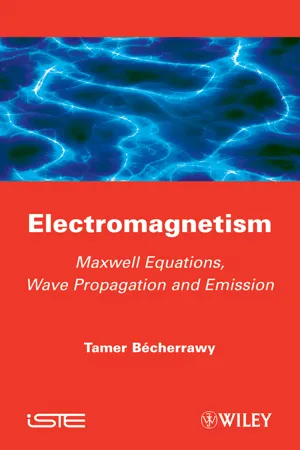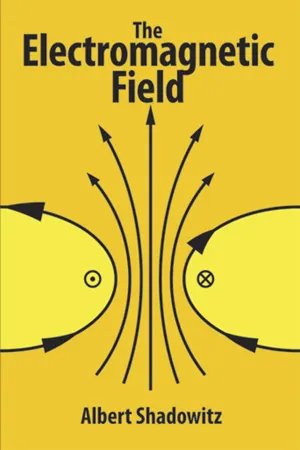Physics
Retarded Potential
Retarded potential is a concept in electromagnetism that describes the electromagnetic field generated by a moving charged particle. It is the potential at a point in space and time due to the motion of a charged particle at an earlier time. The retarded potential is used to calculate the electromagnetic field at a given point in space and time.
Written by Perlego with AI-assistance
Related key terms
Related key terms
1 of 4
Related key terms
1 of 3
3 Key excerpts on "Retarded Potential"
- eBook - ePub
Electromagnetism
Maxwell Equations, Wave Propagation and Emission
- Tamer Becherrawy(Author)
- 2013(Publication Date)
- Wiley-ISTE(Publisher)
They show that we must take into account the time delay due to the propagation if the charge q or its position varies. We note that equation [ 15.77 ], which determines t ', may be very complicated. It may have no roots; then, the potentials vanish at the considered position and time. If it has several roots / i, the potentials are the superpositions of the potentials produced by the particle at the corresponding positions and arriving at M at the same time t. To understand the physical meaning of the Retarded Potentials and fields, let us consider the following simple example: assume that a charge q is initially at rest at the origin O and it is suddenly accelerated at t = 0 to have a velocity v q. At t < 0, the field configuration is that of a particle at rest, i.e. B = 0 and E = q r /4πεr 3 (spherically symmetric). After / = 0, the field is deformed. It is evident that a test charge placed close to O will feel this deformation before a test charge placed far away. A test charge located at a distance R from O feels this deformation only after the time / = R/v. At this time, the source charge q is no longer at O but a point O ' such that 00' = v q t. At a given time /, the sphere of radius R = ct divides the space into two regions: outside the sphere, where there is only the spherical symmetric electric field E = q r /4πεr 3 of the charge q at rest and inside the sphere, where we have both electric and magnetic fields with the electric field having no spherical symmetry. If the charge velocity is small, compared to the propagation speed of the wave (P q << 1), the correction factor g(t') is almost equal to 1 - eBook - ePub
- Jerry Marion(Author)
- 2012(Publication Date)
- Academic Press(Publisher)
CHAPTER 7The Liénard-Wiechert Potentials and Radiation
Publisher Summary
This chapter discusses the ultimate sources of all electromagnetic radiation—namely, moving charges. Radiation can be produced only if a charge undergoes acceleration. There are many interesting applications of accelerating charges—the production of X-rays, the acceleration of charged particles to velocities approaching the velocity of light, the radiation from antennas, etc. If the currents are steady, the equation for the vector potential is valid. The calculation of the potential requires a retarded-time integration over the entire volume containing charge that contributes to the potential Φ. The chapter describes radiation from a charged particle confined to a circular orbit and from an accelerated charged particle at low velocities.7.1 Introduction
In this chapter we shall be concerned with the ultimate sources of all electromagnetic radiation, viz., moving charges. We shall find that radiation can be produced only if a charge undergoes acceleration. There are many interesting applications of accelerating charges—the production of X-rays, the acceleration of charged particles to velocities approaching the velocity of light, the radiation from antennas, etc. We shall study the radiation fields associated with these processes and will find a close similarity in the results. In Chapter 13 some of the results obtained here will be derived from the standpoint of relativity theory.7.2 Retarded Potentials
We found in Section 4.6 that the scalar and vector potentials could be calculated from the expressions [cf. Eqs. (4.38) and (4.39) ]In these equations we have explicitly indicated that the potentials are to be computed at a position designated by the radius vector r by integrating ρ and J throughout V by considering these quantities to be functions of the radius vector of integration r ′. The distance between the integration point r ′ and the point at which Φ and A are computed is |r’ − r′ |, and dv ′ is the volume element at r - eBook - ePub
- (Author)
- 2012(Publication Date)
- Dover Publications(Publisher)
r . The mathematics is then much more complicated, but the conclusions about ingoing and outgoing waves are identical.FIGURE 19-2Liénard.Wiechert Potentials
We now apply these Retarded Potentials to the case of a charged particle moving with constant velocity along the x axis. (This follows an argument given by Panofsky and Phillips, pp. 343-344.) Figure 19-2 shows an imagined, information-collecting sphere converging at the speed c on the point P such that, when the sphere reaches P at t = t, the charge is at the origin O. At some retarded time t’ = t − R/c the sphere crossed the charge at some point Q on the latter’s trajectory before it reached O.Consider that the charge is distributed over some finite volume; the extent of this volume is not germane to our argument, and nothing is changed if we decide to go over to an infinitesimal volume. Also, let dS be an infinitesimal area on the collection sphere. While the information-collecting sphere shrinks in radius by dR , during the time dt, the amount of charge crossed would be, if the charge were at rest relative to O (or P ), [ρ ]dS dr . But, since it is actually moving, it will beThenInserting this into the retarded formula for ϕ (r,t ) and A(r,t ):For a point charge the denominator assumes the value [R − β · R ]. Thus we finally obtain the formulas for the potentials at time t in terms of the retarded position and velocity of the moving charge:These are known as the Liénard-Wiechert potentials.When the velocity of a charge is not constant it is necessary to calculate the potentials and fields at t = t in terms of its retarded position and velocity, but for the special case of constant velocity it is possible to find expressions in terms of the present position and velocity, at t = t. We leave it to the problems to show that [R − β · R] = where θ is shown in Fig. 19-2 ; then we can find ϕ and A directly. The results are identically the same as those found, relativistically, in Sec. 14-1, Chap. 14. (The primes of the result there refer to the 0′
Index pages curate the most relevant extracts from our library of academic textbooks. They’ve been created using an in-house natural language model (NLM), each adding context and meaning to key research topics.
Explore more topic indexes
Explore more topic indexes
1 of 6
Explore more topic indexes
1 of 4


